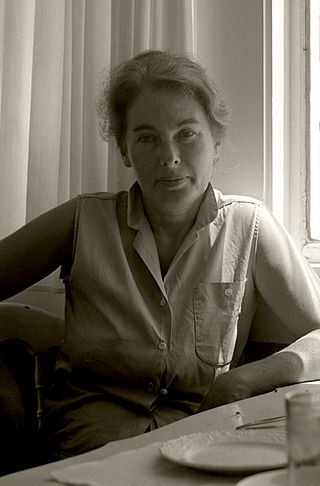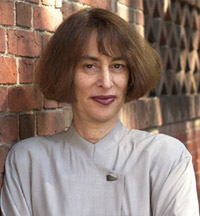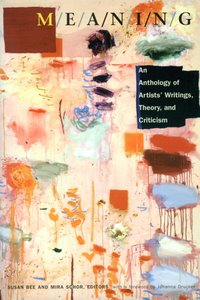
Ida Applebroog was an American multi-media artist who was best-known for her paintings and sculptures that explore the themes of gender, sexual identity, violence, and politics. Applebroog was the recipient of multiple honors including the MacArthur Fellowship "Genius Grant", the College Art Association Distinguished Art Award for Lifetime Achievement, and an Honorary Doctorate of Fine Arts from the New School for Social Research/Parsons School of Design. Applebroog lived in New York City and is represented by Hauser & Wirth.
Faith Wilding is a Paraguayan American multidisciplinary artist - which includes but is not limited to: watercolor, performance art, writing, crocheting, knitting, weaving, and digital art. She is also an author, educator, and activist widely known for her contribution to the progressive development of feminist art. She also fights for ecofeminism, genetics, cyberfeminism, and reproductive rights. Wilding is Professor Emerita of performance art at the School of the Art Institute of Chicago.

The feminist art movement in the United States began in the early 1970s and sought to promote the study, creation, understanding and promotion of women's art. First-generation feminist artists include Judy Chicago, Miriam Schapiro, Suzanne Lacy, Judith Bernstein, Sheila de Bretteville, Mary Beth Edelson, Carolee Schneeman, Rachel Rosenthal, and many other women. They were part of the Feminist art movement in the United States in the early 1970s to develop feminist writing and art. The movement spread quickly through museum protests in both New York and Los Angeles, via an early network called W.E.B. that disseminated news of feminist art activities from 1971 to 1973 in a nationally circulated newsletter, and at conferences such as the West Coast Women's Artists Conference held at California Institute of the Arts and the Conference of Women in the Visual Arts, at the Corcoran School of Art in Washington, D.C..
Vanalyne Green is an American artist who also teaches and writes about culture. She has screened her video work extensively in the United States and abroad, including The Whitney Biennial (1991), American Film Institute, Rotterdam International Film Festival, the Videotheque de Paris, The Robert Flaherty Film Seminar, The Guggenheim Museum and many other museums, universities and film festivals. She has received a Guggenheim Foundation fellowship, as well as grants from Creative Capital, the Jerome Foundation, the Richard H. Driehaus Foundation (2003), the National Endowment for the Arts, the New York State Council of the Arts, and a Rome Prize at the American Academy in Rome (2001–2002). Her work has been covered in the Village Voice, the Los Angeles Weekly, The Chicago Reader, and Artforum. Publications by and about, and interviews with, Green also can be found in "Performance Artists Talking in the Eighties" by Linda M. Montano, "Women of Vision" by Alexandra Juhasz, in addition to M/E/A/N/I/N/G: An Anthology of Artists' Writings, Theory, and Criticism. Green's videotape "A Spy in the House that Ruth Built" was listed as one of the 1,000 best films ever made by film critic and author Jonathan Rosenbaum.

Resia Schor was a Polish-born artist who lived and worked in New York City from 1941 until her death in 2006.

Naomi Schor was an American literary critic and theorist. A pioneer of feminist theory for her generation, she is regarded as one of the foremost scholars of French literature and critical theory of her time. Naomi's younger sister is the artist and writer Mira Schor.

Susan Bee is an American painter, editor, and book artist, who lives in New York City. In 2015, "Photograms and Altered Photos from the 1970s" were exhibited at Southfirst Gallery in Brooklyn. She had one solo show at Accola Griefen Gallery (2013) and nine solo shows at A.I.R. Gallery in New York. She has a B.A. from Barnard College and a M.A. in Art from Hunter College. She has taught at the School of Visual Arts MFA in Art Criticism and Writing program. Bee has taught at the University of Pennsylvania and at Pratt Institute. In 2014, Susan Bee was awarded a Guggenheim fellowship.

M/E/A/N/I/N/G was an art publication for dissenting viewpoints. Founded in 1986 by Susan Bee and Mira Schor as a magazine for and by artists, it was first published in New York in December, 1986.
The feminist art movement refers to the efforts and accomplishments of feminists internationally to produce art that reflects women's lives and experiences, as well as to change the foundation for the production and perception of contemporary art. It also seeks to bring more visibility to women within art history and art practice. The movement challenges the traditional hierarchy of arts over crafts, which views hard sculpture and painting as superior to the narrowly perceived 'women's work' of arts and crafts such as weaving, sewing, quilting and ceramics. Women artists have overturned the traditional view by, for example, using unconventional materials in soft sculptures, new techniques such as stuffing, hanging and draping, and for new purposes such as telling stories of their own life experiences. The objectives of the feminist art movement are thus to deconstruct the traditional hierarchies, represent women more fairly and to give more meaning to art. It helps construct a role for those who wish to challenge the mainstream narrative of the art world. Corresponding with general developments within feminism, and often including such self-organizing tactics as the consciousness-raising group, the movement began in the 1960s and flourished throughout the 1970s as an outgrowth of the so-called second wave of feminism. It has been called "the most influential international movement of any during the postwar period."
Mary Beth Edelson was an American artist and pioneer of the feminist art movement, deemed one of the notable "first-generation feminist artists". Edelson was a printmaker, book artist, collage artist, painter, photographer, performance artist, and author. Her works have been shown at the Museum of Modern Art, the Smithsonian American Art Museum, and the Museum of Contemporary Art in Chicago.
Feminist art criticism emerged in the 1970s from the wider feminist movement as the critical examination of both visual representations of women in art and art produced by women. It continues to be a major field of art criticism.
Katy Deepwell is a feminist art critic and academic, based in London. She is the founder and editor of n.paradoxa: international feminist art journal, published 1998-2017, in 40 volumes by KT press. She founded KT press as a feminist not-for-profit publishing company to publish the journal and books on feminist art. KT press has published 8 e-books, supported by the Andy Warhol Foundation for the Visual Arts. In Feb 2017, Katy Deepwell wrote and published a MOOC on feminism and contemporary art at. In May 2020, a second advanced course on feminist art manifestos was added to the site. The model for both MOOCs is FemTechNet’s DOCC: Distributed Open Collaborative Course.
Vernita Nemec, also known by the performance name Vernita N'Cognita, is a visual and performance artist, curator, and arts activist based in New York City. She earned her BFA at Ohio University in 1964 and has resided in New York City since 1965. She is also known for her soft stuffed sculpture, collages, artist's books, photographs, and installations. Nemec adopted the pseudonym "N'Cognita," a pun on incognito, as a way to honor artists who have not become well-known.

Janet Henry is a visual artist based in New York City.
Hilary Robinson is a British academic and art theorist. She is Professor of Feminism, Art, and Theory at Loughborough University's School of Social Sciences and Humanities. She was Dean of the School of Art and Design and a professor at Middlesex University, and previously served as Dean of the College of Fine Arts at Carnegie Mellon University. Her research focuses on the history, theory, and practice of feminist art.
Bradley Rubenstein is an American artist and writer who lives in Brooklyn, New York. His figurative paintings, prints, and drawings combine elements of biology, psychology, and art historical references.
Carol Greene Duncan is a Marxist-feminist scholar known as a pioneer of ‘new art history’, a social-political approach to art, who is recognized for her work in the field of Museum Studies, particularly her inquiries into the role that museums play in defining cultural identity.
David Humphrey is an American painter, art critic, and sculptor associated with the postmodern turn in painting that began in the late 1970s. He is best known for his playful, cartoonish, puzzling paintings, which blend figuration and abstraction and create "allegories" about the medium of painting itself. Humphrey holds a BFA from Maryland Institute College of Art (1977) and a MA from New York University (1980), where he studied with film critic Annette Michelson; he also attended the New York Studio School from 1996 – 1997. He has been the recipient of many awards including the Guggenheim Fellowship in 2002, the Rome Prize in 2008, and the American Academy of Arts and Letters Purchase Award in 2011. He was born in Augsburg Germany and raised in Pittsburgh, Pennsylvania. He lives and works in New York City.
Elke Solomon is an artist, curator, educator and community worker. She is known for her interdisciplinary practice that combines painting, drawing, object-making, performance and installation. She has exhibited widely in the United States and abroad.

Memorial To A Marriage (2002) is the first marriage equality monument worldwide.
















